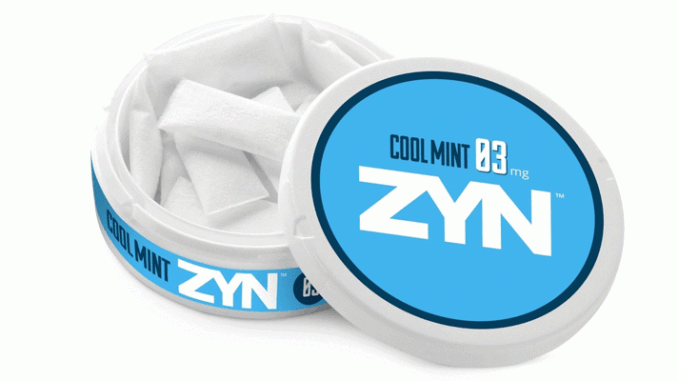
Zyn, a smokeless nicotine pouch not unlike classic tobacco products like snus, has seen a large spike in production and sales in the U.S. market since its introduction in 2016. With this has come an increase in use among teenagers, with some observing a trend where the product is drifting towards a younger audience in an effort to capitalize on the vaping bans nationwide.
Zyn comes in a circular can or tin made of plastic. Inside consumers find 15 white pouches containing a flavored or unflavored nicotine compound that is meant to be placed between the upper lip and gums. The pouches release nicotine into users bloodstream creating a buzzing effect that is meant to last one hour.
Zyn differs from traditional nicotine products in that it does not contain tobacco. Not unlike JUUL, a product also maligned for its effect on youth, Zyn markets itself as a safer, cleaner alternative to smoking, vaping or oral tobacco.
However, nicotine has negative effects on the body even without the presence of tobacco. Rather than being safer, it is just as dangerous and as addictive as other modes of intake.
Sales of Zyn took off after Congress passed H.R. 2339 — the Protecting American Lungs and Reversing the Youth Tobacco Epidemic Act on Feb. 9 2020. When this law restricted vaping products, it created a gap in the market. Swedish Match, the manufacturer of Zyn, announced a doubling of sales to the tune of 150 million cans in 2020 in comparison to 2019.
This was a result of the law creating a gray area where products like Zyn, being smokeless and tobaccoless were technically not beholden to the same restrictions as other nicotine products.
It is possible to ship this product to the house of someone under the legal age of 21 where in the case of vaping products it can be illegal, like in New York, to ship a product at all.
Zyn’s appeal to youth, aside from its perceived safety is it’s inviting flavors. In the US it comes in coffee, cinnamon or citrus. These flavors are different from the taste of raw tobacco that would commonly accompany cans of dip or snus sold in the US.
According to the Truth Initiative, there is a steady buildup of young users. They report, “13% of 15-24 year olds surveyed in Fall 2020 were past 30-day users of pouches.” In comparison, 14% of all adults smoke cigarettes according to the Center for Disease Control.
If in such a short amount of time nicotine pouches like Zyn and its competitors ON! and Velo are able to create a strong user base that rivals cigarettes, it is unclear how much growth they will have in the future and what the staying power will be for their products.
Swedish Match only intends to ramp up production and expansion in the US with it’s “Phase 3 Plan” taking effect soon. A product with tobacco cessation could have far reaching effects on even more corners of the country.
What is clear is that this is not a safe alternative to smoking or vaping. Nicotine pouches can cause gum irritation, sore mouth, hiccups and nausea according to experts.
Swedish Match stated in its second quarter report: “For the Smoke free product segment, continued momentum for ZYN in the US drove the financial performance. Sales and operating profit also grew in Scandinavia.”
